In Filipino culture, food isn't just sustenance - it's how we show love, especially during times of grief. Beef Sopas, with its warm, creamy broth and tender chunks of meat, is a staple at Filipino funerals, particularly during lamay (wake) where family and friends gather to remember their loved ones through the night. When neighbors and relatives come bearing aluminum pots of this soul-warming soup at 2 AM, it's more than just a midnight meal - it's a gesture of solidarity and comfort.
The rich, milky broth, tender beef, and soft macaroni create a comforting bowl that somehow makes those long, emotional nights a little more bearable. While this dish graces many happy occasions, too, there's something particularly meaningful about sharing a steaming bowl of sopas during these solemn gatherings.
This version, made with both beef cheeks and corned beef, offers an extra layer of heartiness that's especially welcome during those late-night vigils.
What is Beef Sopas?
Beef Sopas (Sopas na Baka) is a beloved Filipino macaroni soup that elevates classic comfort food by combining tender beef cheeks and corned beef in a rich, milk-enriched broth. This hearty dish features perfectly cooked elbow macaroni, sweet carrots, and aromatic herbs, creating a creamy, satisfying soup that serves as both a nourishing meal and a traditional remedy for cold days or when feeling under the weather. Unlike its more common chicken counterpart, this beef version offers a deeper, more complex flavor profile while maintaining the signature silky texture that makes Sopas a cherished staple in Filipino households.
Jump to:

Why You'll Love This Recipe
- Perfect comfort food that warms both body and soul
- Rich, creamy texture with deep beef flavor
- Kid-friendly yet sophisticated enough for adults
- One-pot meal that's both filling and nutritious
- Ideal for cold weather or when feeling under the weather
- Versatile recipe that can be customized to your taste
Ingredients
This recipe combines tender beef cheeks for richness, canned corned beef for convenience and flavor depth, and elbow macaroni for heartiness. The evaporated milk creates the signature creamy texture while garlic, onions, and herbs build a flavorful aromatic base.
Carrots add natural sweetness and a pop of color. Together, these ingredients create the perfect balance of comfort, nutrition, and authentic Filipino flavor that makes Beef Sopas so beloved.
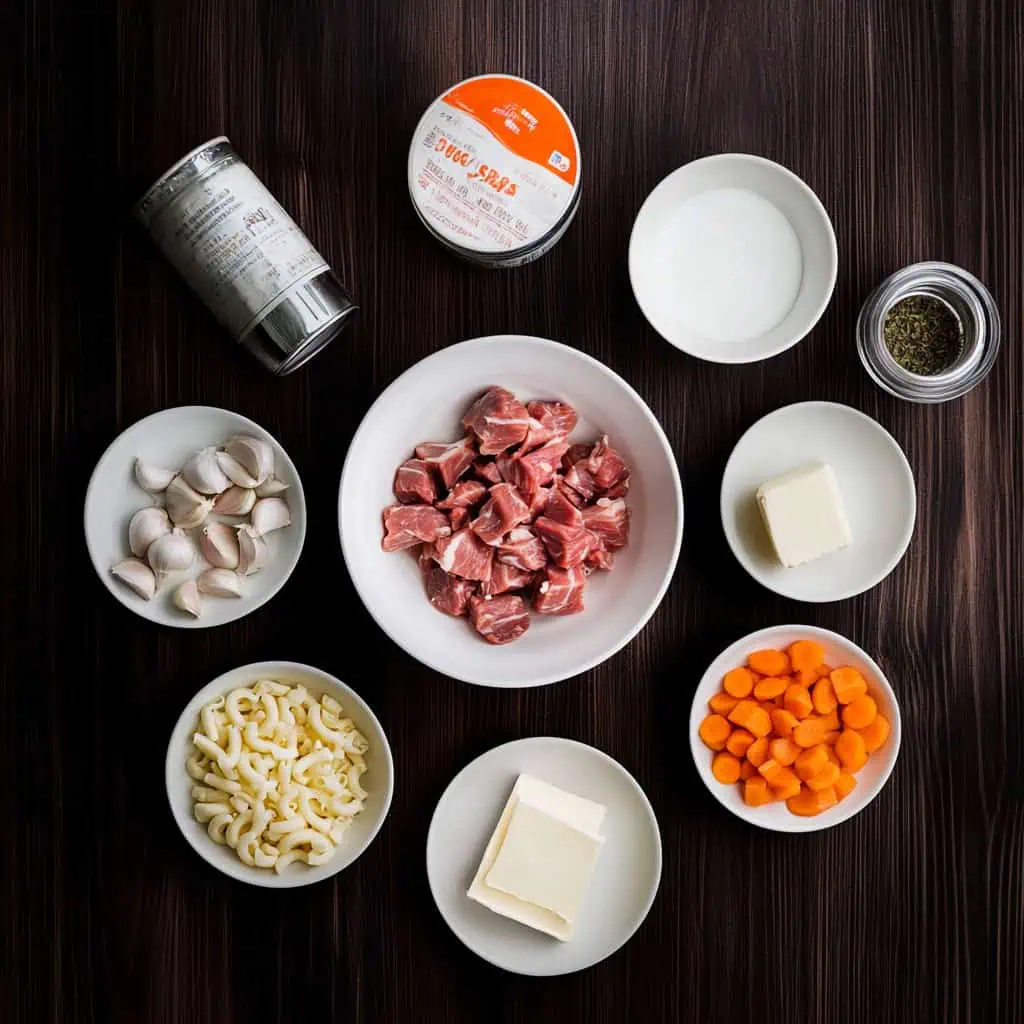
- 2½ cups elbow macaroni
- 2 cups beef cheeks, diced into 1-inch cubes
- 250 g canned corned beef
- 6-8 cups beef stock
- 1 large carrot, diced
- 1 large can evaporated milk
- 1 large white onion, finely chopped
- 4 cloves garlic, minced
- 2 tablespoons butter
- Freshly ground black pepper
- ½ teaspoon dried thyme
- ½ teaspoon dried basil
- Salt to taste
Equipment
- Large heavy-bottomed pot: Essential for even heat distribution and preventing burning
- Sharp knife: For precise cutting of beef cheeks and vegetables
- Cutting board: Preferably with a groove to catch meat juices
- Measuring cups and spoons: For accurate measurements of ingredients
- Wooden spoon: For stirring without scratching your pot
- Ladle: For serving the sopas into bowls
- Colander: For draining macaroni if cooking separately
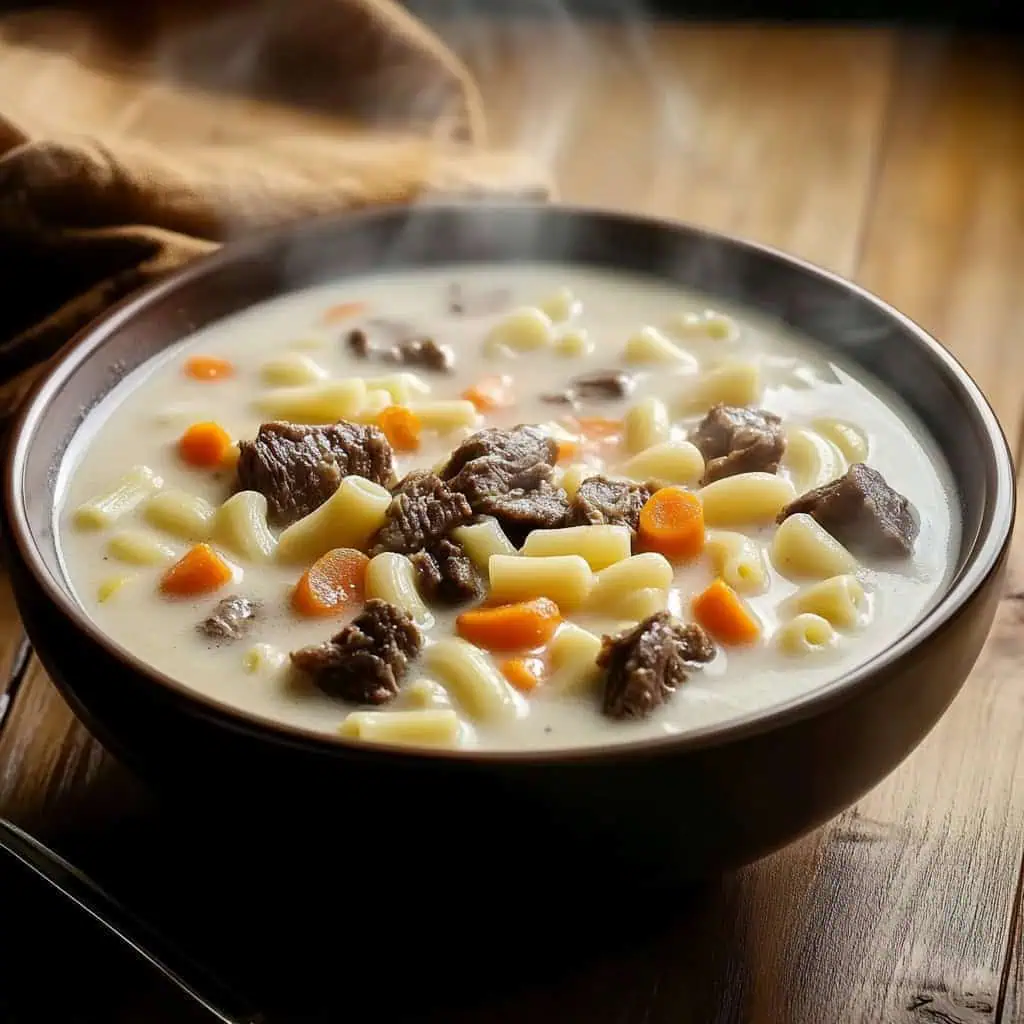
How To Make
- Heat your pot over medium heat. While waiting, prepare and organize all your ingredients.
- Put butter in the pot and let it melt. Add the chopped onions and cook until they look clear and soft, around 3-4 minutes. Add the minced garlic and cook until you can smell its aroma, about 1 minute.
- Add the diced beef cheeks and cook until they turn brown on all sides, about 5-7 minutes. Pour in the beef stock and wait for it to boil.
- Once boiling, add your diced carrots and corned beef. Lower the heat and let it cook slowly for 40 minutes, or until you can easily cut through the beef with a spoon. Stir every now and then, and add hot water if the liquid gets too low.
- When the beef is tender, add your macaroni, thyme, and basil. Cook for another 15 minutes, stirring gently until the macaroni is cooked but still a bit firm when you bite it.
- Pour in the evaporated milk and stir carefully. Let it heat just until you see tiny bubbles, then turn off the heat right away. You don't want the milk to form lumps.
- Add salt and black pepper to taste. Let it sit for 5 minutes - this makes it taste even better.
- Serve hot in bowls. If you like, you can add chopped green onions on top. Enjoy with toasted pandesal on the side.

Tips from Lola's Kitchen
- Make your own beef stock by simmering beef bones with onions and carrots for 3-4 hours before starting this recipe - it creates an incredibly rich base
- Cook the beef cheeks a day ahead for even more tender meat and deeper flavor
- Add milk gradually while stirring constantly to prevent curdling
- Season at the end when the flavors have concentrated - you'll use less salt this way
- Don't rush the cooking process - the slow simmer is what develops the complex flavors
- If using a pressure cooker for the beef, reduce cooking time to 20 minutes on high pressure
- Save some beef stock to add when reheating leftovers as the pasta will continue absorbing liquid
Substitutions
- Beef cheeks: Chuck roast, beef brisket, or stew meat work well as alternatives
- Evaporated milk: Full-fat coconut milk for a dairy-free option with tropical notes
- Elbow macaroni: Any small pasta shape like shells or ditalini
- Beef stock: Chicken stock can be used, though the flavor will be lighter
- Fresh herbs: Use 1½ teaspoons each of fresh thyme and basil instead of dried
- Corned beef: Leftover roast beef or even ground beef in a pinch
- Butter: Olive oil or beef tallow for a different flavor profile
Troubleshooting
- Soup too thin: Remove lid and simmer an additional 10-15 minutes to reduce
- Beef still tough: Continue simmering until fork-tender, adding more hot stock as needed
- Macaroni too soft: Next time, cook pasta separately and add to individual bowls when serving
- Milk curdling: Lower heat before adding milk and never let it boil after adding
- Soup too bland: Add a dash of fish sauce (patis) for umami depth
- Too thick after refrigeration: Add warm stock or water when reheating
Storage & Reheating
- Refrigerate: Store in airtight containers for up to 3 days
- Freeze: Freeze without pasta for up to 3 months in freezer-safe containers
- Thawing: Transfer from freezer to refrigerator overnight
- Reheating: Warm gently over medium-low heat, stirring occasionally
- Add liquid: Stir in additional warm stock when reheating as pasta will have absorbed broth
- For best results: Store pasta and soup separately if planning to freeze
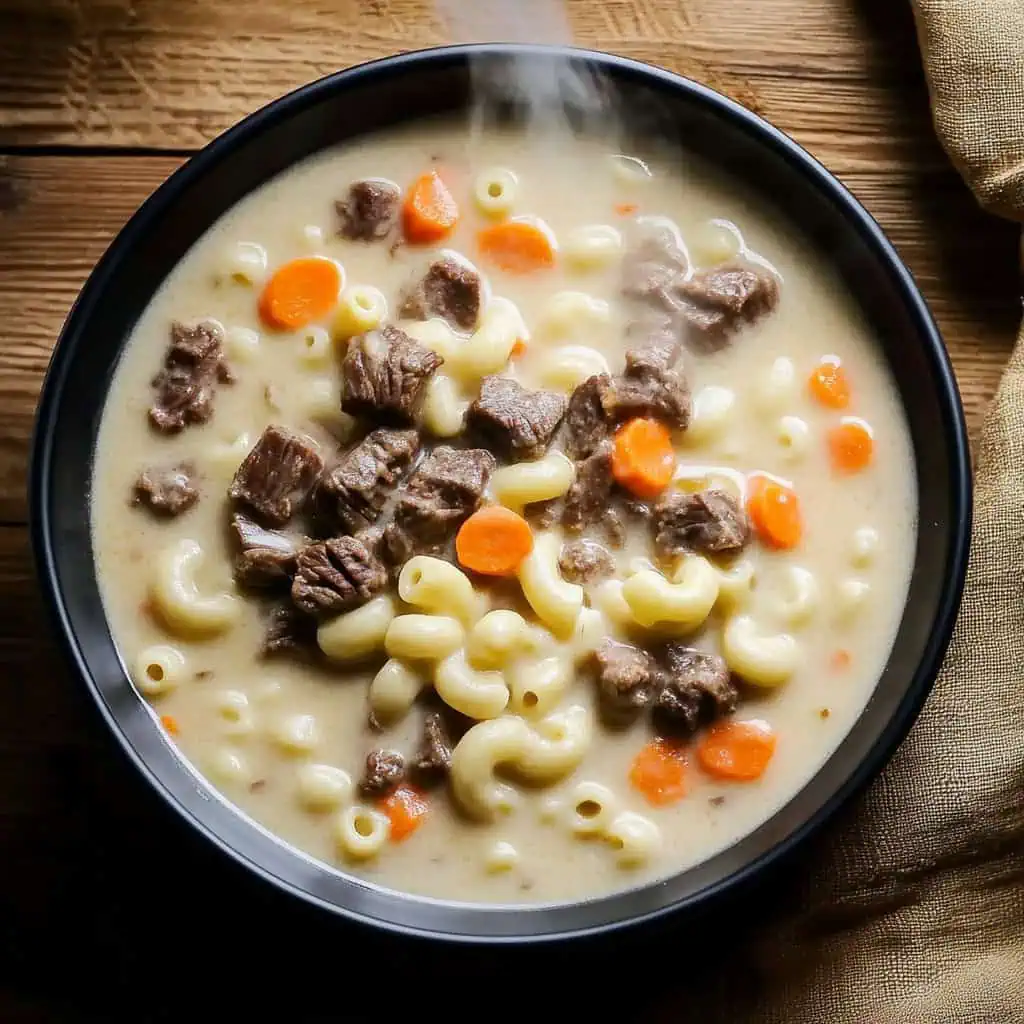
FAQ
Can I make this in a slow cooker?
Yes! Brown the meat and aromatics first, then transfer to a slow cooker with remaining ingredients except pasta and milk. Cook on low for 6-8 hours, add pasta for the final 30 minutes, and stir in milk just before serving.
Why use both beef cheeks and corned beef?
The combination creates a complex flavor profile. Beef cheeks provide rich, gelatinous texture while corned beef adds a savory dimension and convenient protein boost.
Is this soup suitable for freezing?
Yes, but freeze without the pasta and milk. When reheating, add freshly cooked pasta and stir in milk after thawing and reheating the broth.
Can I use regular milk instead of evaporated milk?
Yes, but the soup won't be as creamy. If using regular milk, increase the quantity by 25% and simmer longer to reduce slightly before adding.
How do I make this soup healthier?
Use whole wheat pasta, add more vegetables like celery and cabbage, use low-sodium beef stock, and substitute half-and-half for the evaporated milk.
What makes Filipino Sopas different from other macaroni soups?
The combination of milk and meat in the broth is distinctly Filipino, as is the use of evaporated milk specifically. The recipe also reflects the blend of Eastern and Western influences in Filipino cuisine.
Can I add other vegetables?
Absolutely! Cabbage, celery, potato cubes, and green peas are common additions. Add leafy greens like malunggay (moringa) or spinach at the very end.
Is this soup spicy?
No, traditional Beef Sopas is mild and creamy. For heat, serve with siling labuyo (bird's eye chili) on the side or add a pinch of red pepper flakes.
Related
Looking for other recipes like this? Try these:
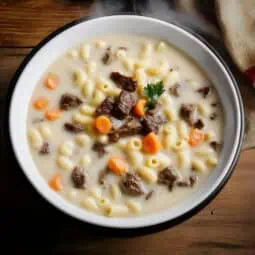
Beef Sopas (Filipino Creamy Beef Macaroni Soup)
Equipment
- Large heavy-bottomed pot (kaldero) For even heat distribution
- Sharp knife (kutsilyo) For precise cutting of ingredients
- Cutting board (Sangkalan) For ingredient preparation
- Measuring cups and spoons (Panukat) For accurate measurements
- Wooden spoon (sandok na kahoy) For stirring without scratching the pot
- Ladle - sandok For serving
- Colander (salaan) For draining macaroni if needed
Ingredients
- 2½ cups elbow macaroni makaroni
- 2 cups beef cheeks pisngi ng baka, diced into 1-inch cubes
- 250 g canned corned beef
- 6-8 cups beef stock sabaw ng baka
- 1 large carrot karot, diced
- 1 large can evaporated milk gatas na evaporada
- 1 large white onion sibuyas, finely chopped
- 4 cloves garlic bawang, minced
- 2 tablespoons butter mantikilya
- Freshly ground black pepper paminta
- ½ teaspoon rubbed thyme dried
- ½ teaspoon rubbed basil dried
- Salt asin to taste
Instructions
- Heat your pot over medium heat. While waiting, prepare and organize all your ingredients.
- Put butter in the pot and let it melt. Add the chopped onions and cook until they look clear and soft, around 3-4 minutes. Add the minced garlic and cook until you can smell its aroma, about 1 minute.
- Add the diced beef cheeks and cook until they turn brown on all sides, about 5-7 minutes. Pour in the beef stock and wait for it to boil.
- Once boiling, add your diced carrots and corned beef. Lower the heat and let it cook slowly for 40 minutes, or until you can easily cut through the beef with a spoon. Stir every now and then, and add hot water if the liquid gets too low.
- When the beef is tender, add your macaroni, thyme, and basil. Cook for another 15 minutes, stirring gently until the macaroni is cooked but still a bit firm when you bite it.
- Pour in the evaporated milk and stir carefully. Let it heat just until you see tiny bubbles, then turn off the heat right away. You don't want the milk to form lumps.
- Add salt and black pepper to taste. Let it sit for 5 minutes - this makes it taste even better.
- Serve hot in bowls. If you like, you can add chopped green onions on top. Enjoy with toasted pandesal on the side.
- For leftovers, let it cool completely before storing in the refrigerator. When reheating, do it slowly over low heat, stirring gently. Add a splash of hot water or stock if it's too thick.
Tips from Lola's Kitchen
- Start with cold water when making the beef stock for clearer broth
- Don't overcook the macaroni - it will continue to soften in the hot soup
- Add milk at the end to prevent curdling
- If soup is too thick, add hot beef stock or water, not cold liquid
- Toast garlic slightly for extra flavor (but don't burn it!)
Nutrition
The Story Behind Filipino Beef Sopas
In the heart of Filipino cuisine lies Beef Sopas, a dish that perfectly embodies the fusion of Eastern comfort and Western influence. This creamy macaroni soup, known locally as "Sopas na Baka," emerged during the American colonial period when pasta made its way into Philippine kitchens, blending seamlessly with local cooking traditions that valued slow-cooked broths and communal dining.
Originally crafted as a humble chicken soup, Sopas evolved in Filipino homes as families experimented with different meats and ingredients. The beef version gained popularity in the 1960s when refrigeration became more common in urban areas, allowing households to work with beef cuts that required longer cooking times. The addition of evaporated milk, a pantry staple in Philippine homes since the post-war era, gave the dish its signature creamy consistency that sets it apart from other Asian noodle soups.
What makes Beef Sopas particularly special in Filipino culture is its role in community gatherings, especially during wakes and funerals. In these solemn occasions, neighbors would arrive at all hours carrying pots of steaming Sopas, offering both nourishment and comfort to grieving families keeping vigil. The tradition of serving this warm, hearty soup during lamay (wake) speaks to its power as a food that not only fills the stomach but also soothes the soul.
Today, Beef Sopas has transcended its origins as a simple soup to become a beloved comfort food across all social classes. From humble carinderias (local eateries) to modern Filipino restaurants, this dish continues to evolve while maintaining its core identity. Some regions have developed their own variations - Batangas adds malunggay leaves for extra nutrition, while Pampanga's version might include beef liver for added richness. Northern provinces often serve it with a side of siling labuyo (bird's eye chili) for those who prefer a spicy kick.
In Filipino-American households, Beef Sopas has become a bridge between cultures, often served alongside grilled cheese sandwiches or garlic bread instead of the traditional pandesal. Yet regardless of these modern adaptations, the essence of Beef Sopas remains unchanged - it's a bowl of comfort that brings people together, warming both body and spirit with every spoonful.
Whether enjoyed as a rainy day treat, a midnight meal during long wakes, or a warming breakfast on cold mornings, Beef Sopas continues to hold a special place in Filipino cuisine. It stands as a testament to the Filipino talent for adapting foreign influences into something uniquely their own, creating dishes that not only nourish but also tell the story of a culture that values community, comfort, and the healing power of a well-made soup.









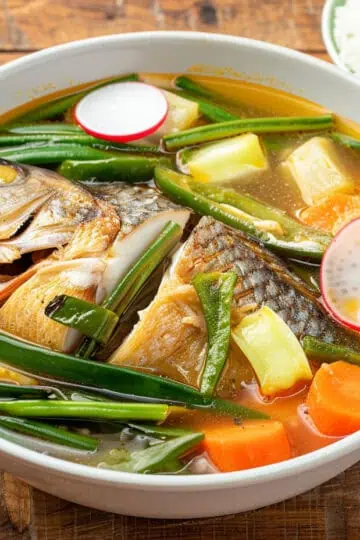
Comments
No Comments